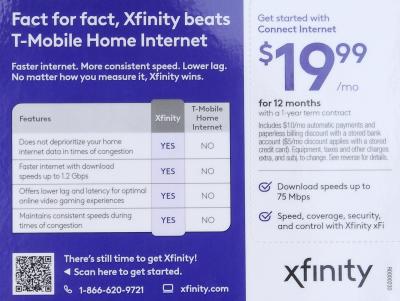Fixed wireless access (FWA) has been a 5G success story over the past couple of years. Fixed wireless wasn’t always a slam dunk – earlier attempts floundered. But in the 5G era, T-Mobile and Verizon fine-tuned the hardware, service and installation process to a point they’re able to generate positive consumer appraisals and steal customers from cable.
Increasingly, “it’s a converged sale,” said Roger Entner, founder of Recon Analytics, during his most recent weekly podcast with Don Kellogg. “The leading indicator for FWA is your mobile provider.”
That’s the strategy of T-Mobile and Verizon, as well as Comcast and Charter Communications. “All of them are trying to make their comprehensive product portfolio better,” he said, adding that AT&T is trying to do the same thing on a more limited basis with Internet Air.
Some people apparently were under the impression that FWA was only a threat to DSL, but it’s also a threat to cable. About nine months ago, Recon Analytics concluded that “FWA is a threat to everybody, and that continues to be true,” Entner said. Based on Recon’s sample of about 12,000 or so FWA customers, 18% never had home broadband before. “That’s a significant expansion of the market.”
During the first quarter of 2023, Verizon added 393,000 FWA net adds, bringing its total FWA subscriber base to 1.9 million. T-Mobile reported 523,000 net FWA adds during the same period, ending with a total of 3.2 million FWA customers.
All of the Big 3 carriers report their Q2 earnings next week.
Mobile + fixed offer
More than three-quarters of T-Mobile’s FWA customers have T-Mobile as their wireless service provider and the same trend holds for Verizon, Entner said. Their anchor product appears to be the mobile service, with the “upsell” being the fixed wireless offering, Kellogg said. Both T-Mobile and Verizon offer lower home broadband/FWA pricing for customers who also use their mobile service.
Of course, Cable and DSL companies are feeling the impact, but even fiber is as well, Entner said. Close to 20% of FWA customers are coming from fiber, “because it’s good enough,” and a lot cheaper, he said.
RELATED: As cable aims to win with wireless, expect more attacks on FWA
That said, the reaction of the big cable companies has been fast and relatively furious. Last year, Comcast launched a website dedicated to slamming T-Mobile’s Home Internet service and plugging Comcast’s Xfinity brand.

More recently, Comcast sent out a mailer advertising a $19.99/month offer for 12 months with a one-year contract for customers new to Xfinity internet. The mailer includes a chart listing four features that Xfinity offers that T-Mobile Home Internet does not offer – all under the heading “Fact for fact, Xfinity beats T-Mobile Home Internet.”
Fierce reached out to T-Mobile for comment on the claims but did not receive a response by press time.
For its part, T-Mobile has demonstrated its own marketing flair with a report describing why cable customers are ditching cable for FWA and stunts like driving a T-Mobile billboard truck around Comcast Center in Philadelphia last year.
Cable’s revenge
While wireless companies take cable customers in the broadband space, cable companies’ revenge, so to speak, is their “massive, massive mobile gains, and we’ll see what happens when they roll out DOCSIS 4.0,” which in the lab is much more reliable than DOCSIS 3 and 3.1, Entner said. “We’ll see if it’s more reliable in the field as well, and what this will do and how they will fight back.”
Analysts at MoffettNathanson pointed out in a report in May that Dish Network was set up by the U.S. government to be the fourth player in the wireless market, replacing Sprint when T-Mobile and Sprint were granted their merger. Fast-forward to Q1 of 2023, and the cable industry added more than 1 million subscribers in just three months, ending with nearly 12 million mobile subscribers combined.
“Cable’s high and rising share of gross additions creates an obvious problem for the incumbent operators,” wrote analyst Craig Moffett. “Cable is crowding out the growth available to the Big Three.” On a net basis, cable accounted for about 75% of total industry phone net additions in Q1, according to the firm.